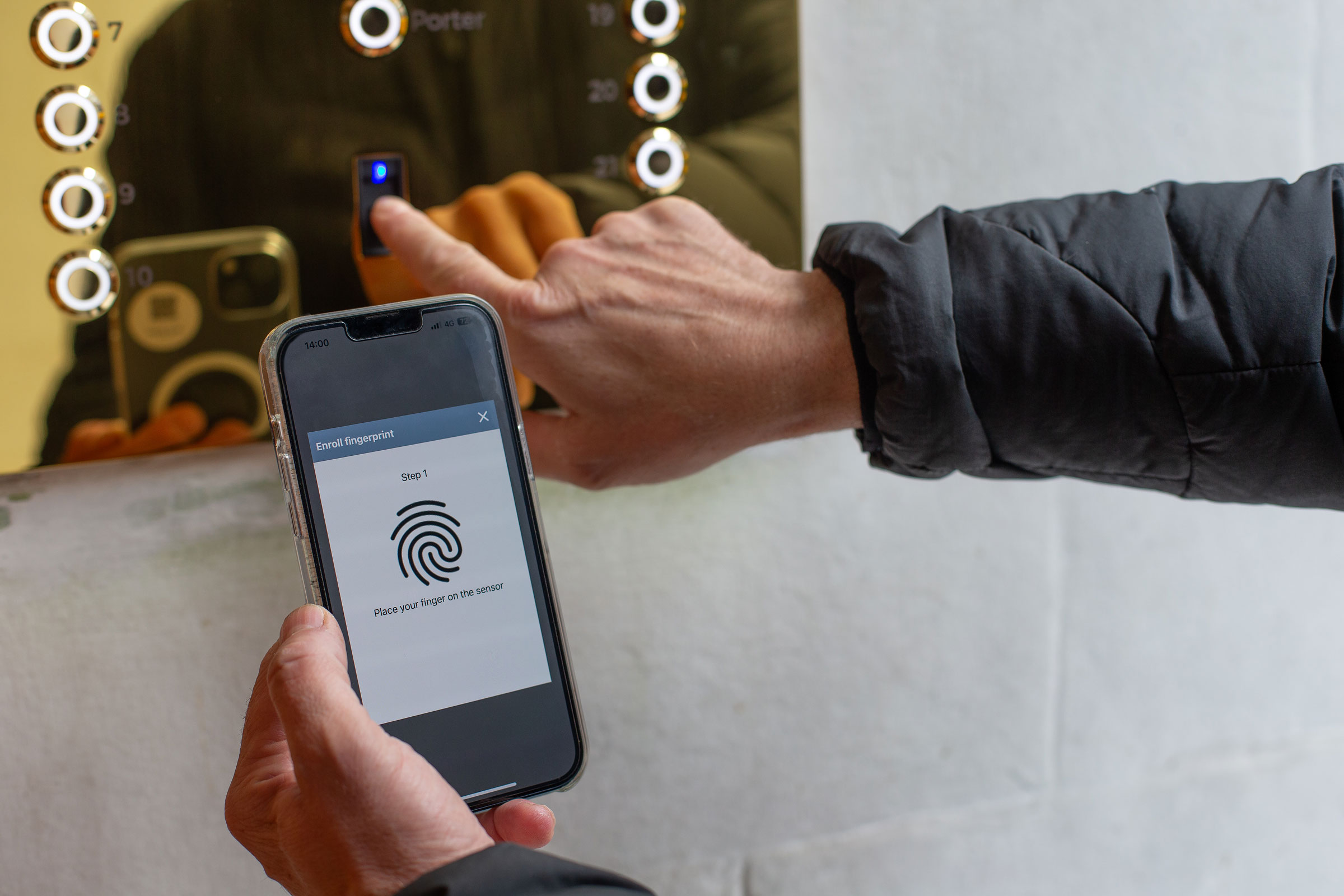Story at a glance:
- Vertical pivot gates offer security outside buildings and save space compared to sliding gates.
- Self-powered doors can both improve access and reduce significant energy.
- Key codes, RFID tags, and Mobile IDs allow for easy access in many building projects.
In an increasingly technological world, who has access to what and how is incredibly important. Who can get into your building? And who has the ability to lock things down?
Access control ranges from guards at luxury housing to fobs on a keychain to secure doors in schools. Authorizing access to a building is a big responsibility, and it’s one that is greatly assisted by new technologies and building solutions.
As more building owners look for how to improve building access, we talked to industry experts about some of the latest solutions.
Cloud-Based Access Controls

Cloud-based access solutions controlled by one’s smartphone eliminate the risks and costs of lost keys. Photo courtesy of Salto Systems
Physical keys and key cards are among the more conventional access solutions, but they aren’t always the most convenient—or sustainable—option, especially when it comes to, say, multi-tenant offices and co-working spaces with a revolving user population.
Physical keys, for example, may be easily lost, and if one falls into the hands of unknown parties, all users must be issued a new key and all locks need to be changed to ensure security remains intact. This not only results in unnecessary material waste but also undue expenses.
Salto, a leading provider of smart building access control systems, created Salto KS—or Keys as a Service—a scalable, cloud-based platform that uses mobile-based digital keys to control building access, track events, and provide a better user experience overall. With Salto KS, building managers are able to instantly grant anyone with a smartphone a mobile-ID that provides access to certain locks across specific timeframes, ensuring maximum convenience while simultaneously maintaining a high degree of security.
Beyond reducing waste associated with physical keys and key-cards, Salto KS’ cloud-based access solutions improve operational energy efficiency thanks to their low-energy locks that go into standby mode when not in active use.
“We’re using low-energy, battery-operated locks that reduce the need for wired installation and the associated energy consumption that lowers the overall energy footprint,” Brittany Lightfoot, hardware product manager at Salto, previously told gb&d.
Intercoms & Door Stations
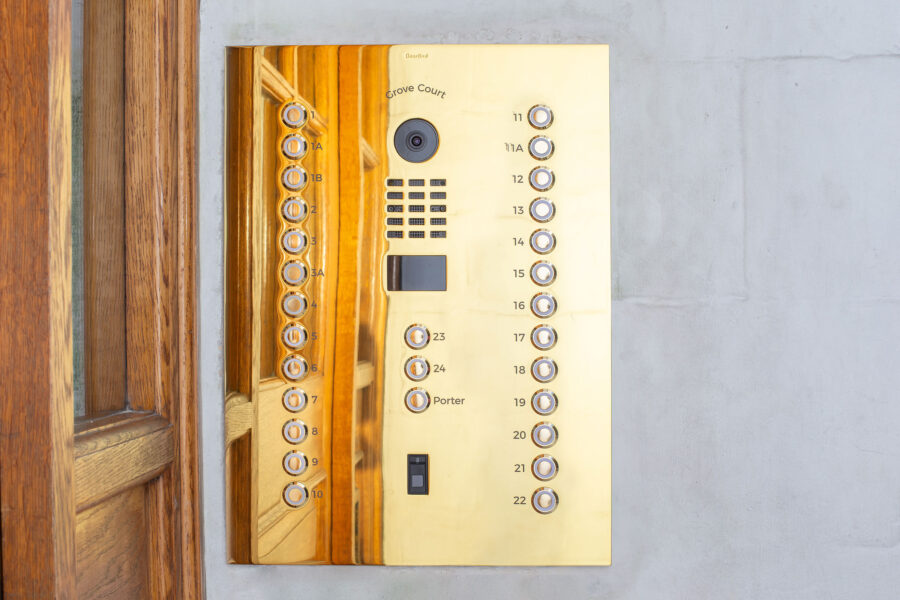
The finishes and style around the intercom and how security is built into a building should be intentional and consistent with the look of the entrance, says DoorBird’s Justin Clark. Photo courtesy of DoorBird
Introduced in the late 19th century, the intercom is one of the most recognizable forms of building access solutions. Intercoms—and door stations in general—allow occupants to communicate via two-way audio with visitors at building entryways and instantly grant access through remote unlocking of the door. Many contemporary intercom systems even use cameras for visual identification of visitors.
And while the intercoms of yesteryear may be boxy and brick-like, modern systems are much more low-profile and offer more opportunities for customization. “Typically something that’s very high tech and very secure doesn’t always match the aesthetic desire of the developer, the architect, or the building owner,” Justin Clark, head of sales in the Americas, Australia, and New Zealand for DoorBird, previously told gb&d. “Design is becoming more focused when it comes to security products that hit the market. Specifically for what we do, that’s always been a focus—technology meets design. We believe firmly that we can create something that is technologically advanced and at the same time looks elegant and is consistent with the architecture of the building.”
DoorBird—a leading manufacturer of IP-based video door intercoms, access control devices, indoor stations, and accessories—takes customization to the next level with their 3D configurator. “We have a configurator that allows you to create custom units, providing real-time pricing so you know what to expect, with more than 50 finishes, real bronze, burnished brass, and more colors,” Clark says. “You can get it right and make sure it’s consistent with the other things you’re designing.
When a visitor comes to a DoorBird station they can hit a call button or dial the number of the person they are trying to reach, at which point the user receives a notification via their smartphone, an indoor station, or an IP-based phone; they can then initiate an audio or video call and decide whether or not to let the person in. Indoor door stations are also available for projects where smartphone access may not be desirable—but instead of directly connecting to the intercom, these stations connect back to the door station via the cloud, making them easier and cheaper to install.
“It used to be that we were hampered by having one station in the field that had to have a direct connection back to, say, an office phone, so we were limited,” Scott McChesney, senior project manager of technology for Stantec, previously told gb&d. “Now with mobile credentials they can log onto any computer on the network and interact with the intercom and buzz people in and out of the door. That’s another driving factor behind seeing intercoms being used on doors more than we used to.”
Gating Systems
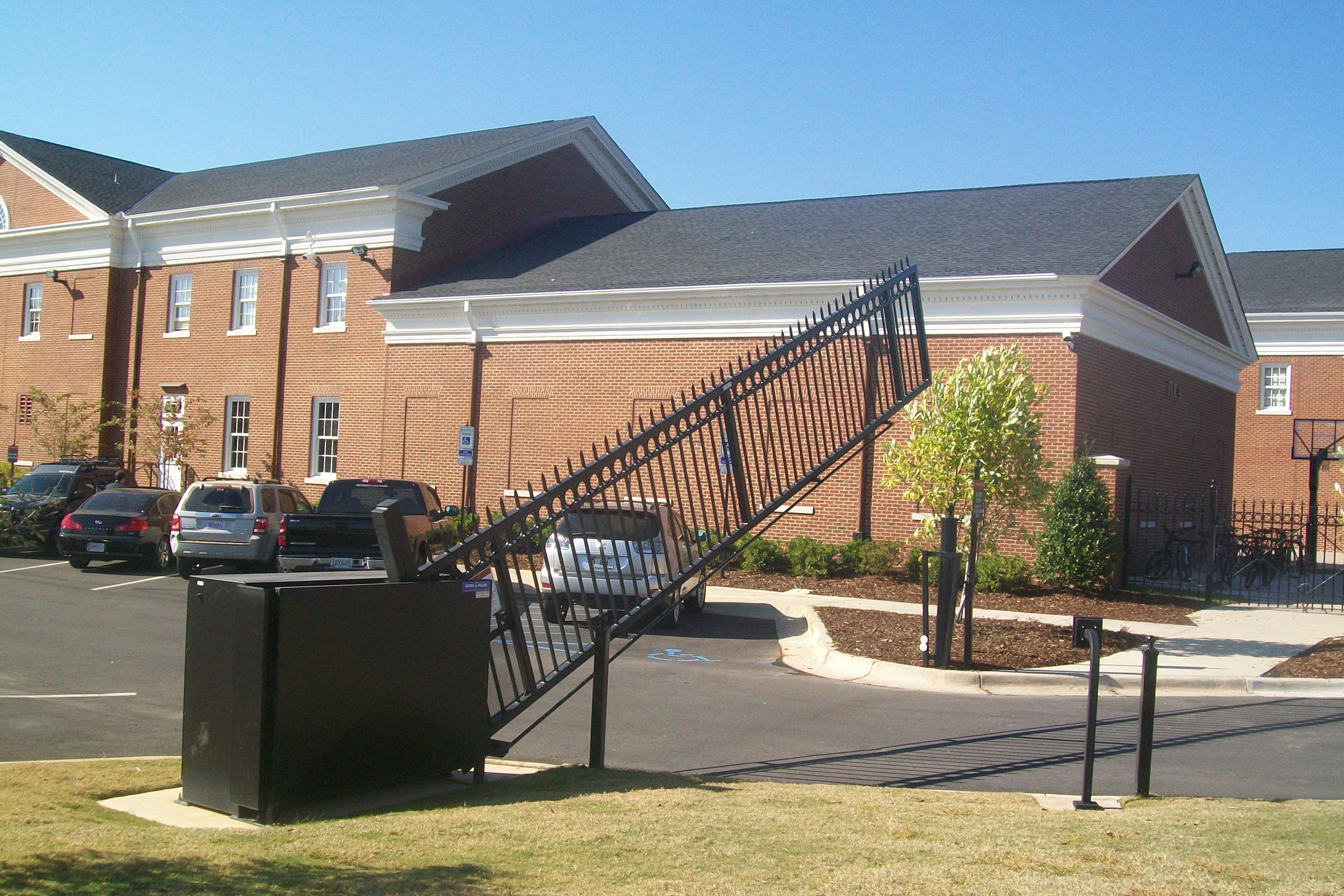
Vertical pivot gates can help provide a high degree of perimter security while simultaneously offering space-saving advantages over swing and sliding gates. Photo courtesy of AutoGate
Automatic gates and fencing are commonplace solutions in perimeter security, but not all gate systems are created equal. Swing and sliding gates, for example, are no slouch when it comes to ensuring site security, but they take up a significant amount of space, can be difficult to install, and offer few opportunities for site-specific customization. There is, however, another style of gate that offers its own set of advantages: the vertical pivot gate (VPG).
Defined as automatic vehicular gate systems that open and close with the same motion of a railroad crossing arm, VPGs are said to offer considerable security, safety, and space-saving advantages compared to both swing and sliding gates. “I think the key advantages of VPGs are their speed to process vehicles, reduced areas pedestrians can be injured, reduced issues with problematic functionality, increased security features, and certainly lower cost of ownership,” Brian Fritz, vice president of business development at AutoGate, wrote in a previous submission to gb&d.
Fritz says the ease of pivot gate installation reduces the need for highly experienced installers and substantially eases the burden of specifiers during project design and construction phases, too.
Guard Booths
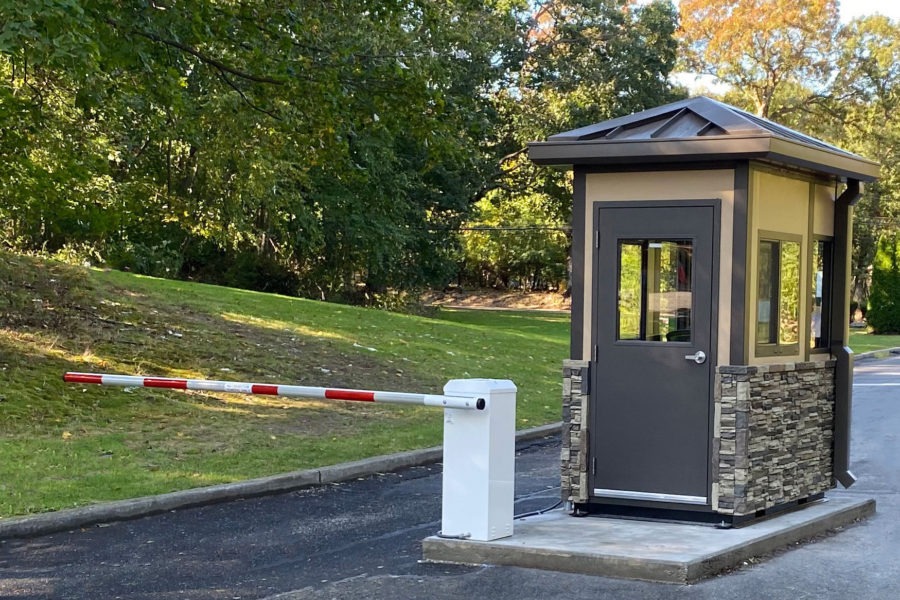
An example of a traditional Panel Built guard booth, designed for workplace access control. Photo by David Grajko
Solutions from Panel Built offer an increased feeling of security, according to PanelBuilt’s Nathaniel Otto.
Otto says guard shacks can be outfitted with an exterior mounted ID scanner so employees can scan the identification themselves, or officers can use handheld scanners to verify the ID through their side window. In both cases, there is a physical barrier between the guard and the employee to protect both parties. Access control points can be operated with a code, access card, fob, or other technology, Otto says.
Panel Built manufactures custom guard booths, guard shacks, and guard houses, among many other offerings. According to their website, their prefabricated guard booths are innately stronger than traditional booths because each individual section is designed to withstand the stress of transportation and assembly. They are also forkliftable for ease of relocation.
Touchless Technology

Delta Controls touchless access systems allow smartphones to grant access and control room temperature and other environmental factors. Courtesy of Delta Controls
Building automation systems are ever-changing, and BAS devices can increasingly connect to access and door control using Bluetooth, Wi-Fi, and IP communication. How does that improve building access? One of the pros at Delta Controls, a global leader in building automation solutions, shared how this and other touchless technology is changing the way we work and get to work.
“Let’s take a boardroom, for example,” Robert Hemmerdinger, chief sales and marketing officer for Delta Controls, wrote in a previous gb&d article. “In a touchless office, the door can be automated using sensors at the entrance or near-field communication between a door access point and a user’s phone. People won’t need to touch the door handle to gain access to the space. Once they’ve entered, lighting can be adjusted automatically, and temperature preferences can be input with the user’s phone.”
Hemmerdinger goes on to explain that, with a relatively low retrofit cost compared to mechanical equipment revision, a teacher can maintain control of classrooms with a phone. “Doors can be automated to be unlocked by staff in the same touchless manner, and motion or pressure sensors can be used to open them by students. With widespread device-level integration, teachers can control the room in the same fashion as an office,” he said.
RFID Tags & Keycards

Digilock offers up products that make flexible workspaces even more secure. Photo courtesy of Digilock
Radio frequency identification (RFID) tags and keycards use a microchip and an extremely small antenna to transmit data to a wall reader via radio waves. RFID tags offer many benefits over conventional physical keys, as the use of a microchip means tags can be programmed with very specific access data for each individual they are assigned to.
RFID-based digital access systems are used across a range of commercial applications, but they are particularly useful in health care scenarios, according to the experts at Digilock, a leading developer of keyless digital lock technology.
“With an integrated access control system, specific personnel can be given access to one area and excluded from another. In the past each department may have been managed separately, but digital locks employ a single footprint, reducing complexity and saving everyone time,” Richard Shaffer, senior account executive at Digilock, wrote in a past contribution to gb&d.
Digilock also offers innovative solutions that allow building managers to limit access to any given lock by user and time of day, as well as review who has access to a storage unit or space and when, all with the click of a button. In our fast-paced era of telecommuting, flexible work arrangements, and multi-shift facilities, Digilock’s products streamline the work building managers do with a seamless experience.
Self-Powered Doors
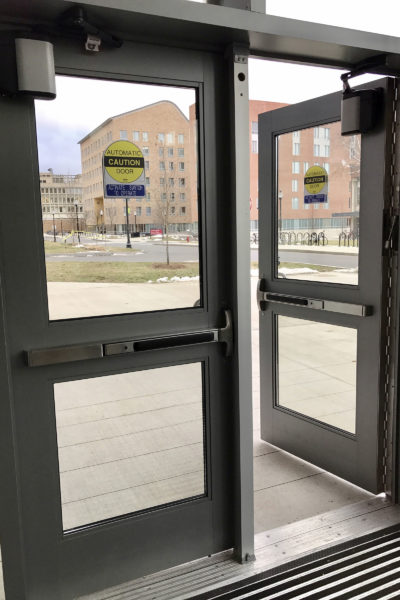
The plug-in 5800 Series ADAEZ is 91% more efficient, and the wireless 5800 Series ADAEZ is 100% more efficient, according to GreenCircle, as compared to similar products. Photo courtesy of ASSA ABLOY
Automatic doors are essential to making a structure ADA-compliant, with many commercial buildings opting to install automatic sliding doors that open when their sensors detect movement. Sliding automatic doors are not, however, always a feasible option, especially when it comes to renovations or retrofits.
In these cases it often makes more sense to install automatic door operators, or those devices which open swing-doors at the press of a push-plate and then close it after a set amount of time has passed. ASSA ABLOY—a global leader in both mechanical and digital access solutions—manufactures many such products, including the 5800 Series ADAEZ line of low-energy door operators.
Traditional automatic door operators are connected to a building’s electrical system and constantly draw electricity even when not actively opening or closing the door, as the system must continuously monitor for activation signals. The problem with this design is that most building occupants will use the door manually rather than press the automatic door operator, meaning a not-insignificant amount of energy is wasted on simply monitoring for signals. But in the case of the ADAEZ Pro, the energy generated by manual operation of the door supplies all of the electricity required for automatic operation, eliminating that constant draw and saving energy..
“The energy from those opens and closes, pushes and pulls, is stored in an onboard rechargeable battery within the door operator,” Amy Musanti, director of sustainable building solutions at ASSA ABLOY, previously told gb&d. When a person arrives at the door and requires the use of a push-button to open it automatically, the required electricity comes from that onboard battery instead of from the grid. That push button can either be wired or, for even easier installation, triggered by radio frequency. In this manner, a door that would normally be a constant power draw is suddenly up to 100% regenerative.
Motor-Powered Locks
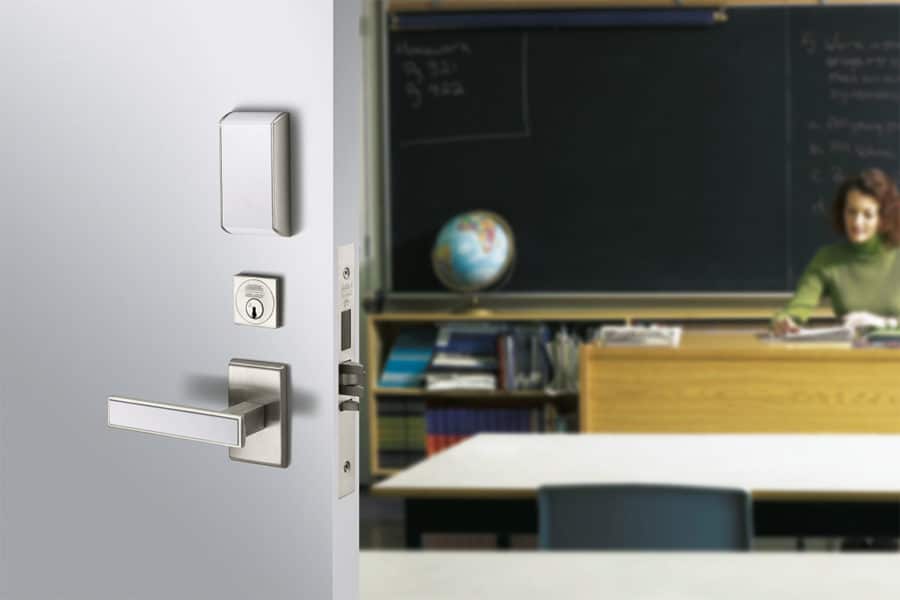
ASSA ABLOY partnered with School Guard Glass and used SARGENT hardware to make even more durable doors. Photo courtesy of ASSA ABLOY
ASSA ABLOY’s EcoFlex electrified mortise lock is another building access solution to consider.
Unlike previous generations of commercial locking systems in which the bolt moved using solenoid, the new iterations are powered by a step driven motor. This way, the locking system remains secure but uses dramatically less energy. In general, ASSA ABLOY’s EcoFlex electrified mortise locks reduce energy use by up to 96%. The EcoFlex electrified exit trims reduce energy use by up to 95%.
Power reductions can result in major savings for the commercial and institutional clients ASSA ABLOY serves. “Even for folks who may not be thinking of sustainability as a core value of their business, there isn’t anybody who isn’t looking at the bottom line,” Peter Boriskin, vice president of commercial product management at ASSA ABLOY Americas, told gb&d in a previous publication. “And when you actually can do good, where’s the harm? Everybody can find something about it that’s beneficial.”
Laura Rote contributed to this article.

